Inspired by Appendix N fever, I recently picked up and read Sterling Lanier's
Hiero's Journey (1973), which I'd never read before -although I soon realized that as a teenager I'd read some of its derivative works, like the nearer-future
World Enough, And Time, and the farther-future
Dark Is The Sun. For Lanier wrote the original post-apocalyptic, mutant-fauna, ancient-artifacts, psychic-powers fantasy, in which a heroic priest-mentalist and his psi-sensitive moose steed wander across the Great Lakes region millennia after the nuclear holocaust, gathering a band of unlikely allies to fight a cabal of evil psychic sorcerers.
Naturally, it has been noticed that Gamma World was pretty much an attempt to go gaming in this setting. What
isn't recognized so much is how Lanier's universe also influenced the constitution of D&D from the supplements onward (although
some are hip). Specifically, once you take out the mythical, natural and Tolkienesque creatures from the D&D wilderness tables, what you're left with is a mix of giant-sized animals, animal-men, and oddball mutant creatures. That's pretty much
my "WEIRD" table when I tried to sift wilderness monsters into six different genres, and that's pretty much what Hiero finds, day in, day out, in his journey. The ancient ruins, the long distances between tiny points of civilization, all can be laid down to Tolkien; but the roll-four-times-a-day, teeming encounter-fest of D&D, that's Lanier.
Artifacts, too. There's a scene in Hiero's Journey that has to have inspired the artifact examination rules in Gamma World, where Hiero finds a strange device on the body of an evil sorcerer, and tries to find out what it does, at the end going as far as to prop it up and jab at its last button with an eight-foot stick. But this kind of procedure also describes D&D magic items. Unlike the heroes of folklore or fantasy, who come into fairly straightforward items as gifts or treasure trove, the heroes of D&D, like the far-future explorers of the ruins, have to contend with a relic of the ancients being possibly cursed. The artifacts section in the Dungeon Master's Guide even suggests creating random benefits and drawbacks. So, when your adventurers gingerly try out that new potion or necklace, they're acting more post-apocalyptic than fantasy -- acting out of wariness, rather than awe.
And then there's psionics, and perhaps only an obsession with Hiero and the Deryni novels can explain why Gary mixed mental powers with magic in both editions he had his hands on. It's pretty clear that the D&D psionic combat system draws on Hiero's many mental duels with evil forces, which describe different modes of attack and defense. Very present in the novel, too, is the central balancing idea for D&D psionics - while characters can luck into these amazing powers essentially for free, using them opens you up to attention from a whole new range of unwholesome entities.
Finally, one thing the illustration reminds me of: like Ursula K. LeGuin's Earthsea series and, a little later, Samuel R. Delany's Neveryon stories, Hiero's Journey is very much a post-Civil Rights movement fantasy, where North America has mainly been repopulated by ethnic minorities, and pale people are barbaric and seldom seen. A reminder, perhaps, that the old school had a more progressive streak to it - think M.A.R. Barker's Tekumel, based on non-European cultures - before all the cliches about Scottish dwarves and the like sunk in.











